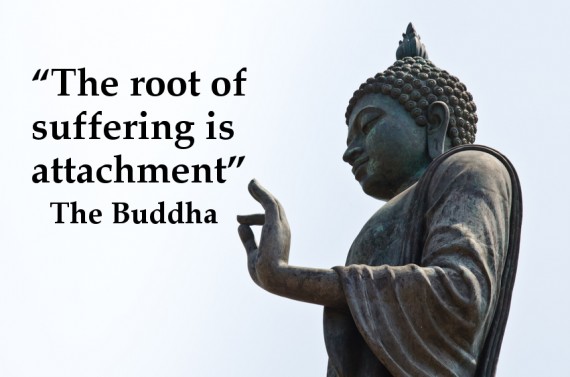Desire leads to attachment, attachment is almost inevitably followed by loss, which causes suffering…
Therefore desire and attachment are at the root of all suffering and we should minimize both in our lives.
Well, I have to say I don’t agree. Not entirely, anyway.
But who am I to argue with the Buddha and millions of followers?
I’m not necessarily disagreeing with the Buddha—although I would argue that our continual evolution does require us to question whether ancient wisdom is still relevant for us now. Sometimes it is but sometimes it isn’t.
We need to use our discernment as individuals regarding what is appropriate for each of us rather than allowing ourselves to become awed by the ancientness of a tradition.
It’s more that the richness and vastness of many teachings, including those of the Buddha, have become overly-simplified and naturally warped with the passing of time. If I’m disagreeing with anything it is with our modern emphasis on speed and superficiality, which reduces even the deepest teachings and subjects to snackable content.
We share and consume tasty spiritual catch phrases with pretty pictures across social media, reassuring ourselves and others as we do so of our righteousness, without necessarily doing the deeper work of finding our own personal truths.
‘Spiritual popcorn’ was the way one friend described this consumption of spiritual wisdom—fast food that doesn’t encourage the consideration and digestion process of a full meal.
Perhaps that’s a little heavy and there’s no doubt that I’d rather see a Facebook newsfeed full of uplifting quotes (even if they lack depth) than one full of selfies and gossip. But I’m heading off on a tangent here so let me get back to what it is I really wanted to address.
Desire and attachment are two of those deeper subjects that deserve considerable more personal reflection and observation that we generally give them. In a consumerist society where those of us with our eyes open can clearly see the negative effects of these two urges—and also witness the consequences of losing what we have become attached to—it is easy to see why practices that teach us to turn away from desire and attachment would be attractive.
It’s a fairly normal response to react to a difficult situation by adopting the opposite stance. We lose a lover for the third time, or our comfortable lifestyle is stripped away following the loss of life savings or a career, and the temptation can be to say, ‘Well, what did I expect? I was caught up in desire and too attached to my lover/car/house/foreign holidays.’
I’ve met more than a few people who have turned to spiritual practices as a means of escape—not necessarily just to escape pain but also to escape life.
Their practice becomes a way of numbing or avoiding the pain rather than a tool that allows them to deal with it and move on. It can be difficult to tell the difference, when we first take up a new spiritual practice, between an approach which is helping us to come to terms with the deeper dynamics of desire, attachment, loss and suffering, and one which encourages us to repress these aspects of ourselves. But I’ll be writing more on that specific angle in another article. Dealing with the pain of loss takes time, sensitivity and understanding and it is a natural instinct to turn to anything—including spiritual practice—which may help to dull it for a while.
While it’s fairly obvious that mainstream, modern society has an unhealthy relationship with desire which has pulled it towards over-consumption and a never-ending quest for gratification, I don’t subscribe to the view that eliminating desire is the solution. Desire is a highly creative energy that can fuel and inspire us to grow and expand.
Additionally, repressing a natural urge is rarely the best way to deal with our difficulties for a variety of reasons.
- It takes energy to keep energy down—so our valuable life force becomes tied up when we push away or repress any part of ourselves.
- We lose an opportunity to understand ourselves better when we aren’t willing to engage with our impulses directly—and it is greater self-awareness that helps us to make choices and create the life that is most fulfilling for who we really are.
- Our psyche has a natural impulse towards wholeness and finds it difficult to contain repressed energy over long periods of time without it leaking out in what can sometimes be a warped expression of the original impulse.
- And, whether we like it or not, we still carry in our energy field the vibration of whatever it is we are repressing— it still becomes part of our energetic make-up, attracting people and situations that match up with it. We may think we have successfully risen above desire, but often times we haven’t, and the evidence of which is more true shows up in our lives.
But what’s the alternative? Desire and attachment are two fundamental and natural aspects of being human. We arrive in the world as newborns and desire helps us to strive for what we need to survive, while attachment helps us to bond with those who can help us not only survive but also hopefully to thrive. As with many aspects of modern life —including sex, alcohol, tobacco and marijuana—it is our relationship with them that is the problem rather than the urge or substance itself.
Part of maturing as a species is developing the ability to take personal responsibility for addressing and integrating aspects of ourselves that may previously have been censored or banned by an external authority.
The alternative to the ‘desire (or sex/drugs/alcohol) is the root of all evil’ perspective is to look within our own lives at the role that both desire and attachment play. When we reframe our relationship to desire and attachment, we can use both in a constructive way in our lives.
Healthy desire shows us what we need and helps us to reach for it.
It may seem to be pointing us in the direction of a new lover, car or career, and that may be all that we think we need (or may, in fact, be all that we do actually need). But there may also be a deeper level of need that we haven’t noticed or acknowledged. Maybe we haven’t been nurturing ourselves sufficiently or perhaps we’re ready to spread our wings and allow some fresh energy into a life that has become a little monotonous. When used with awareness, the energy of desire lifts us out of complacency and our comfort zone, encouraging us to reach for more, prompting us to develop and expand, helping us to reach new and deeper levels of self-expression and fulfillment.
Healthy attachment, on the other hand, ensures that we are engaged with our lives in a way that is meaningful and rewarding.
When we’re attached to our lovers, friends and children, we’re more available to the flow of love that ideally exists in healthy relationships. It can also mean we stay engaged even when times get tough in a way that can bring maturity, understanding and, eventually, deeper love. And yes, it hurts when a loved one moves on or when we lose something precious and there is a gap in our lives where they used to be. But this is also part of our human experience and can be the catalyst to a deeper way of life.
Desire and attachment can show up in a variety of ways—physically, emotionally and mentally—but that doesn’t necessarily mean that the root need they relate to is on that same level. Strong sexual desire may be simply a response to sexual chemistry, but it can also stem from a need to be more physically active, a need for stress relief or a need to feel more confident.
Desire becomes unhealthy only when we respond without thought or awareness to its promptings, and when we become obsessed with only one possible response.
When we are aware of where the desire is coming from within us—and why—we can expand our options. Instead of becoming fixated on a particular person, job or house, for example, we can deal with our desire by acknowledging more generally that we’re ready for change, looking for a new challenge or wanting to find some place that feels more nurturing. With that broader perspective, we are more focused on the vibration of what we want and less attached to a specific way of having our needs met. It frees us—and the universe—up to be more creative in meeting our deeper needs while still allowing the strongly creative energy of desire to flow through our lives.
Specifically, when we come to view desire in this way, we release lovers, friends and even children, from the burden of our attachment to their behaving in particular ways in order for us to feel secure and comfortable.
There are a few questions we can ask ourselves about our relationship to desire and attachment which are eternally valid for any situation that makes us uncomfortable or seems to have a limiting effect on our self-expression.
- What do I desire? What am I attached to? Dig deep and don’t accept the first answer—keep asking why. Why do I want that job? Why do I want money? What’s really at the root of what I want?
- How and under what circumstances does desire and attachment show up in my life? Are there particular times or places where they show up more than others? What can that tell me about any underlying dynamics?
- How do they make me feel? Am I comfortable and strong with my feelings of desire and attachment? Or the opposite? Do I get an adrenaline rush from desire which makes me feel alive when I may not otherwise feel that vibrant?
- How do I respond to them? Do I automatically yield? Do I resist? What are my patterns around desire and attachment?
- What consequences to my responses to them have? Do I use desire and attachment in a life-enhancing way or am I limiting myself (or others) with the way in which I use them?
The answers to these questions—if we’re willing to allow sufficient time and energy to observe and reflect on the truth of our answers—can lead us to greater self-awareness. When we have a deeper understanding of what they may be telling us, we then have choices about how we.
Learning to integrate desire and attachment in a way that is respectful of ourselves and others as well as of our home planet, may be one of the keys to living a balanced life in a world of infinite attractions.
Love elephant and want to go steady?
Sign up for our (curated) daily and weekly newsletters!
Editor: Renée Picard
Photo: elephant archives







Read 9 comments and reply